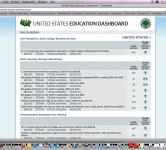Data–including big data and learning analytics–has incredible potential for teaching and learning
 The term “big data” is everywhere and, in a nutshell, is the term used today to describe large collections of data that companies use to personalize their products and services.
The term “big data” is everywhere and, in a nutshell, is the term used today to describe large collections of data that companies use to personalize their products and services.
But what does this concept mean for K-12 education? Well, for starters, increased knowledge of individual students can lead to personalized teaching and learning. This is called learning analytics, which involves using big data for educational purposes, as defined by the New Media Consortium K-12 Horizon Report. The report is produced in collaboration with the Consortium for School Newtworking (CoSN), which recently released a report that examines, in-depth, learning analytics’ potential.
School districts already use data, but learning analytics would enable educators to use this data to a greater extent, examining what the report calls “student-level data” and using that information to determine how students are learning, what might help them learn better, and what teacher practices are or are not having an impact on this learning.…Read More



